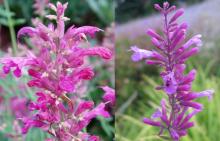I've had this plant out in the front yard for a few years now, where it has been very slow to bulk up... it's some sort of late-blooming Agastache, which I have assumed was A. cana. Is it? What do the Agastache experts say?
It blooms in September/October:
Comments
Re: Which Agastache species?
Am I right in assuming you meant to say, "in the key, it comes closest to A. cana"? (I think so, from the context of your message.)
Thank you very much for the ID , Mark!
Re: Which Agastache species?
Am I right in assuming you meant to say, "in the key, it comes closest to A. cana"? (I think so, from the context of your message.)
Thank you very much for the ID , Mark!
Sorry Lori, I wasn't clear, so I edited the message to say " In the key, A. cana comes closest to A. rupestris". However, your plant does look like A. cana from what I can make of it, or perhaps even a hybrid of it.
Re: Which Agastache species?
Thanks for the clarification. I don't recall where the seeds came from... if from garden origin, I suppose it could be a hybrid.
Re: Which Agastache species?
I have grown something from a local nursery near Albany NY called Agastache cana Rosea for many years, not always winter hardy, but self seeds enough to keep it going. A magnet for pollinators of all stripes and a good filler for the sunny boarder.
Re: Which Agastache species?
Harold, do you recall what the foliage aroma is like? The one aspect of these plants I'm most attracted to is the strong aromatic characteristic of the foliage; whenever I pass by a plant I little take a little pinch to enjoy the heady aromas these plants exude.


I've only grown the two species and a few hybrids so far, so it's hard for me to say for certain what species or hybrid your plant represents. Googling Agastache cana show many variable forms and colors of this plant, primarily in pink shades. I put one of your photos (on the right) side by side with one shown on a US Forest service link (on the left), the inflorescence certainly has similarities. The foliage too, matches the species description.
I wish the Flora of North America would be finished, to get better coverage on genera that are not easy to find reference material on. I dug into my old copy of Flora of New Mexico from Wooten and Standley, Contributions from the National Herbarium, Smithsonianum Institution, 1915, and 9 Agastache species were described back then for New Mexico, including A. cana. In the key,
itA. cana comes closest to A. rupestris; not cinereous as in rupestris, and having broader ovate to crenate-dentate leaves unlike the linear leaves of rupestris.US Forest Service page on Agastache rupestris, and a close-up of A. cana
http://www.fs.fed.us/wildflowers/plant-of-the-week/agastache_rupestris.s...
http://www.fs.fed.us/wildflowers/plant-of-the-week/images/threadleafhyss...
A. cana on RMRP
http://www.rmrp.com/Photo%20Pages/AA/Agastache%20cana%20100DPI.htm
Agastache cana has the following common names: Wild Hyssop, Hummingbird Mint, Mosquito Plant, Bubble Gum Mint
I wonder if the "mosquito plant" name might refer to the use of the aromatic leaves to repel mosquitos, just guessing?
And "bubblegum mint", to refer to the flower color, or was this minty plant literally chewed?